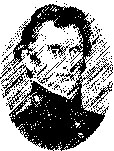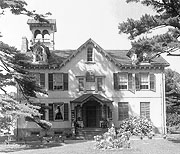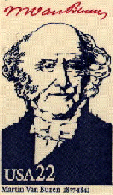 |
on Executions by Hanging in New York State (Page 8: 1816 - 1817) |

|
With links to more information on selected cases.
Open | Close
|
Can you fill any data gaps? Please e-mail webmaster Thomas C. McCarthy at NYCHS@nyc.rr.com | |
| 1816 | A black male named Ishmael Frazer was hanged on Jan. 20 for arson.*
A white male named Lewis Gerteau was hanged on July 12 for murder.*
Francis Allair, aka de Alert, under sentence to die by hanging July 26, 1816, was hanged twice on that appointed day, according to some accounts -- once by his own hand in his cell that morning to cheat the gallows and once by the sheriff who hung the dead body in order not to be done out of his execution fee. Given that set of circumstances, Allair's death does not technically qualify as an execution. But it is included here because his double hanging reveals interesting aspects of how capital punishment was carried out in that period. The tale is recounted in more detail
Francis and his father Charles, arrested in the murder of Peter Miller at Champlain, were freed from the Clinton County jail in 1813 when the British raided Plattsburgh.
The two fled to Canada but were nevertheless indicted in absentia in 1814. When Francis crossed back into the U.S. at Champlain in 1816, he was re-arrested, soon tried, convicted, and sentenced to death. Some in the large crowd that had gathered for the "Frenchman's" execution expressed disappointment at the announcement that the condemned man had taken his own life. But the sheriff's reaction went beyond annoyance; he took action to make sure he would be recompensed for his execution preparations, according to a report attributed to a witness of the event. Dr.William Beaumont, an Army physician with the Plattsburgh-based 6th Infantry Regiment, was said to have been given the prisoner's body. Beaumont, through research later in his career, became known as the "Father of Gastric Physiology."
|
||||
1817 |
The two Tuhis were both part of the Brothertown community. One source, Oneida County Sheriff Department Lt. Tim Conboy's A Look Back in History, says the victim, Joseph Tuhi, was John's brother. Another source, Annals of Oneida County on Northeast Wigwam, says Joseph was John's cousin. Both sources agree the Tuhis had been drinking, became intoxicated, quarreled over some money, and that an enraged John axed Joseph in the head.
Apparently they had attended a militia muster in Clinton near Utica before the quarrel that ended in Joseph's death in the town of Paris. After a coroner's inquest and an indictment, John was tried at the courthouse in Rome, Oneida County. District Attorney Thomas H. Hubbard prosecuted. Thomas H. Hubbard appears to have also been neighboring Madison County's first Surrogate. Convicted, Tuhi was sentenced to be hanged "on 25th day of July when next, between 10:00AM and 2:00PM."
An estimated crowd of 15,000 showed up for the public hanging in Utica. Because of the turnout, Oneida County Sheriff Apollos Cooper of Utica, his Under Sheriff John B. Pease, their deputies and the condemned teenager journeyed from Whitesboro to the execution site, Corn Hill, in Utica with military troops as escorts. He was hanged from a tree on the hill.
Both John and Joseph Tuhi had been members of the Brothertown tribe, formed decades earlier by Christian Indians from Long Island and New England areas. During the Great Awakening, a religious movement in the 1740s, several Native Americans converted to Christianity but faced hostility from unconverted Indians and treachery from whites with un-Christian converting of tribal lands. So a small band of converts took refuge with the more tolerant Oneidas in north central NY. Wanting to live in brotherhood, they named their new community Brothertown.
Ironically, the condemned youth bore the honorable name of a revered peacemaker among the Brothertowns: John Tuhi, Esq.
According to Town of Marshall historian Mrs. Dorothy McConnell, among the first Brothertown Indians to settle -- before the Revolutionary War -- in that part of what became Oneida County were John Tuhi and Elijah Wampy. The victim in an 1801 Oneida County murder case, Eunice Peters, was a daughter of Elijah Wampy. [For more about Wampy, his daughter, her murder and the execution of her husband George Peters for it, see Page 4 in this series.]
.
John Tuhi, Esq., had been a lead negotiator for the Brothertowns with the Western Indians in 1801. According to Jane Stevens-Hodge's transcription of Our County and Its People, the Brothertowns' tribal post of peacemaker was roughly equivalent to that of Justice of the Peace. A Brothertown Peacemaker would have "Esquire" affixed to his name. Peacemaker John Tuhi, Esq., died at age 65 six years before John Tuhi, convicted murderer, was hanged.
On Oct. 17, 1817, Margaret Houghtaling aka Margret Houghthling was hanged in Hudson, Columbia County's count seat, for murder.
One web page about women executed states she was convicted of killing her baby but that, after the execution, a neighbor confessed to the crime.
The web page does not explain the basis for that assertion but the information may have come from an 1887 pamphlet mentioned on two other web pages (listed below). The publication's title reads, in part:
". . . . MAGGIE HOUGHTALING. AN INNOCENT WOMAN HANGED. THE TRUTH REVEALED AT LAST. A STARTLING CONFESSION."
The apparent fact that the execution took place in Hudson, the county seat of Columbia County, raises an interesting question for speculation. The man who would become the county's most famous historical figure was at the time of the Houghtaling case the attorney general of New York State: Martin Van Buren.
In 1782, the future 8th President of the United States was born in a part of then Albany County that four years later became Columbia County. At age 26, he moved from his hometown of Kinderhook to the country seat after his being appointed Columbia County Surrogate in 1808.
In 1812, while still Surrogate, Van Buren also became a member of the state's highest court, then called New York Court for the Correction of Errors but now the Court of Appeals. He gave up judicial robes to become State Senator in 1813. It was through his alliances there that he also obtained appointment in 1815 as state attorney general, a post he held into 1819 simultaneously with his State Senate office.
During much of the 19th Century, a state attorney general or an assistant state attorney general might found at the prosecution table, along with the local district attorney, trying a capital murder case in most any one of the counties of New York.
As NYS Court of Appeals Chief Judge Judith S. Kaye wrote, in the 1997 majority opinion supporting the governor's legal authority to supersede the Bronx County District Attorney in a potential death penalty prosecution involving a slain police officer:
More than a century ago . . . the attorney general possessed plenary power to prosecute crimes and was assisted in doing so by the district attorney.
Actually, the plenary role of the state's attorneys general in prosecuting criminal cases was in evidence more than two centuries ago. It was most visible at the capital trials held in the courts of oyer and terminer.
While web research so far has not found anything directly connecting his office to the Houghtaling case, its taking place right in his own home region must have been a matter of some interest to State Attorney General Van Buren officially, and possibly even politically, given its emotionally sensitive aspects. Whether he exercised the plenary prosecution powers of his office in the Houghtaling case is an intriguing question. It is especially intriguing since we do know that Attorney General Van Buren did exercise his plenary powers in 1819 to join the Delaware District Attorney prosecuting reputed ex-Tory Nathan Foster on charges of wife murder.
For more information, see
|
|
Back to Page 1: 1779 - 1784
Back to Page 2: 1785 - 1791 Back to Page 3: 1792 - 1794 Back to Page 4: 1795 - 1801 |
Back to Page 5: 1802 - 1806
Back to Page 6: 1807 - 1812 Back to Page 7: 1813 - 1815 Forward to Page 9: 1818 - 1819 |
More 'Timeline on NYS Executions' under construction.
To |
To Executions |




